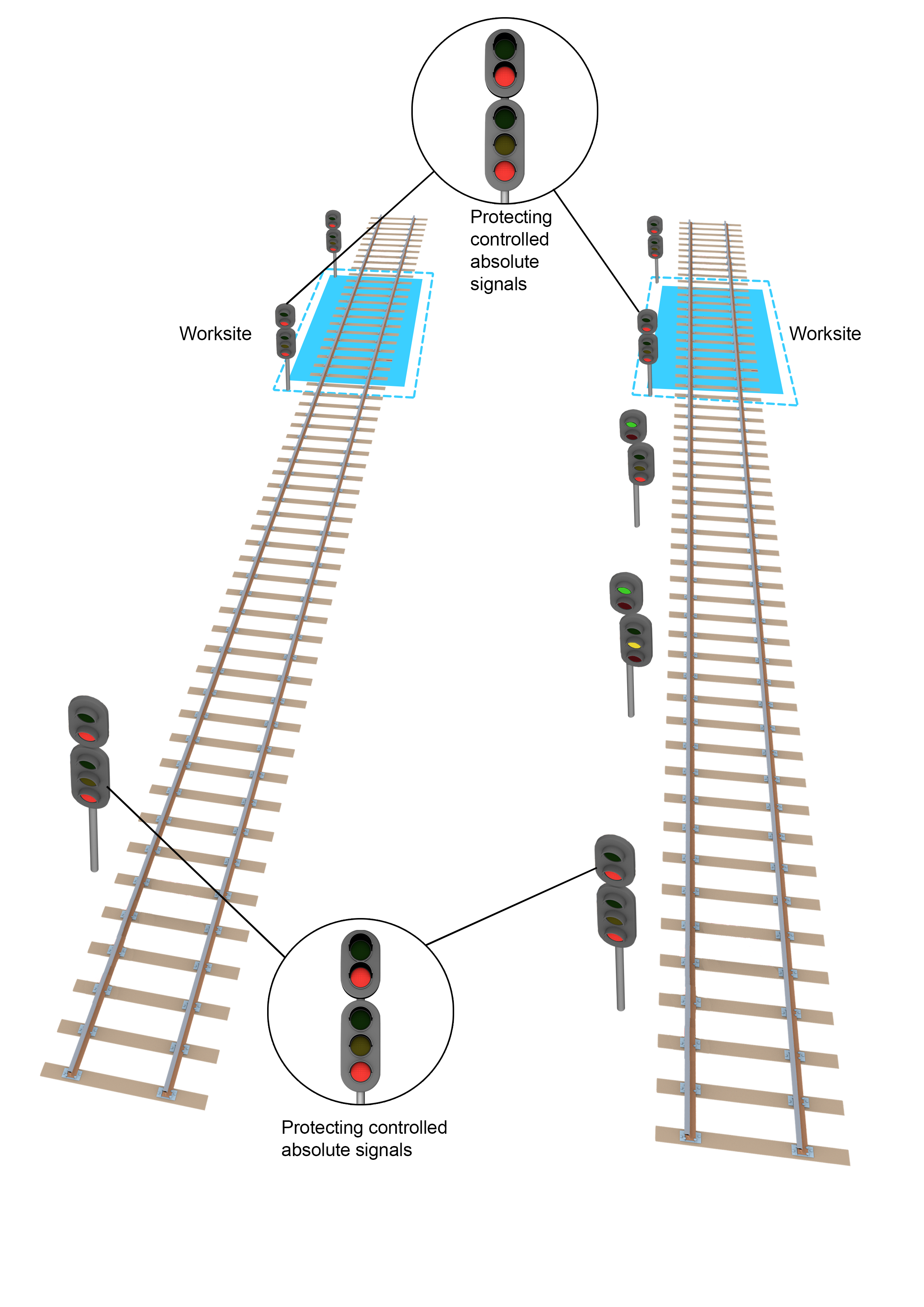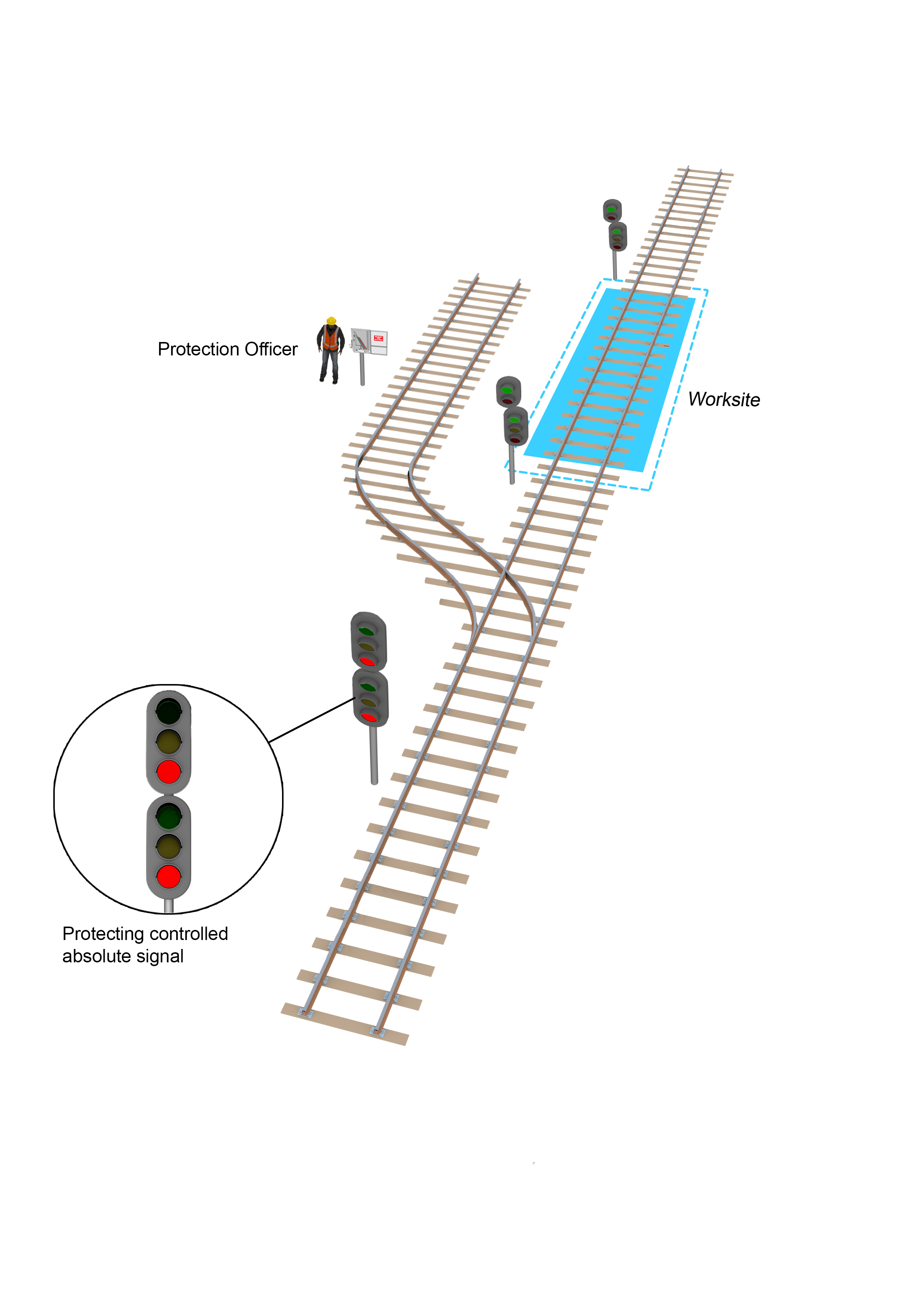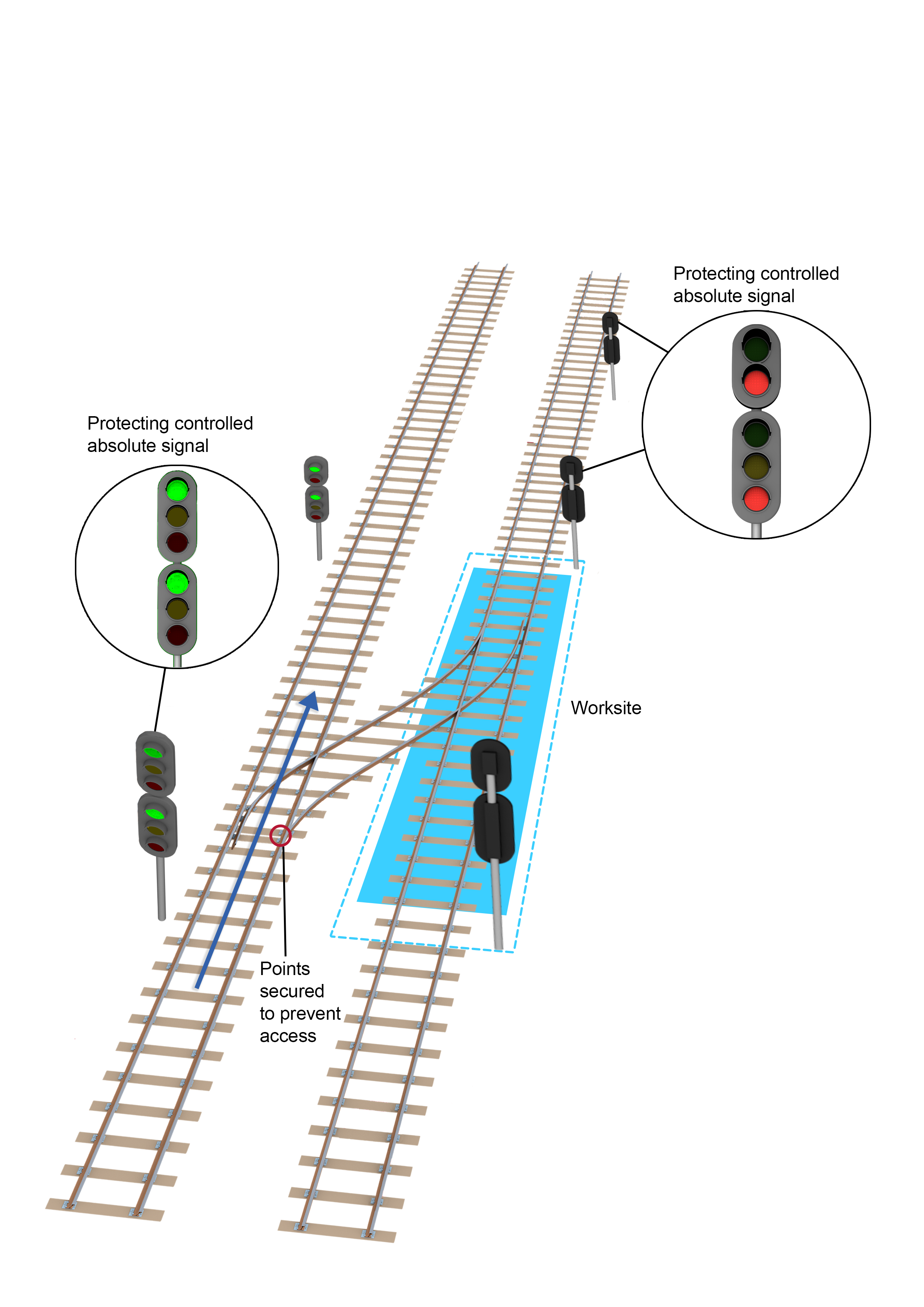Description
This document describes the procedure for using Absolute Signal Blocking (ASB).
Not what you are looking for? See more Procedures
Introduction
Absolute Signal Blocking (ASB) is a method of working in the Danger Zone by excluding rail traffic from a portion of track.
Requesting Absolute Signal Blocking
Protection Officer
- Tell the Signaller:
- your name
- your contact details
- your Safeworking designation
- the type of work
- the intended duration of the work.
- Identify the line by name and define the nominated worksite location as being:
- from one signal to another signal, or
- from a signal to the end of a terminal line.
If the nominated worksite location is on more than one line, the Protection Officer must define the nominated worksite location separately for each line.
Signals used to define the nominated worksite location must be associated with the specified lines and identified by their numbers.
- Tell the Signaller the planned type of ASB protection.
- Ask the Signaller to protect all points of entry into the nominated worksite location by applying blocking facilities to exclude rail traffic.
Signaller
- Confirm the ASB details including:
- the Protection Officer’s name and contact details
- the type of work
- the duration of work
- the line name
- the nominated worksite location
- the type of ASB protection.
- Use the reference points provided by the Protection Officer to identify the nominated worksite location.
- Identify if the ASB requires more than one Signaller to exclude rail traffic. If the proposed ASB affects more than one Signaller, the Signallers must nominate an authorising Signaller.
Signaller/Authorising Signaller
- Make sure that:
- blocking facilities have been applied to exclude rail traffic
- the last rail traffic to enter the nominated worksite location is identified and its location is known
- that there is no approaching rail traffic between protection and the nominated worksite location.
Authorising Signaller
- Tell the Protection Officer:
- that blocking facilities have been applied
- that the nominated worksite location is protected
- the identification number of the last rail traffic to enter the nominated worksite location and its last known location
- that there is no approaching rail traffic between protection and the nominated worksite location.
Protection Officer
- Confirm with the Signaller:
- that all points of entry into the nominated worksite location are correctly protected
- the identification number of the last rail traffic to enter the nominated worksite location and its last known location
- that there is no approaching rail traffic between protection and the nominated worksite location.
Types of ASB protection
Two consecutive controlled absolute signals at STOP
One controlled absolute signal at STOP
Workers must immediately move to a safe place when warned by the Lookout about approaching rail traffic.
Unless ASB is suspended or ended, rail traffic must not be authorised to enter the nominated worksite location.
Alternative routes
If the nominated worksite location is protected by two consecutive controlled absolute signals, rail traffic may be authorised to pass only the first protecting signal reached by approaching rail traffic to allow a movement over an alternative route.
Controlled absolute signals immediately protecting the nominated worksite location must remain at STOP.
Signaller
- Before authorising each rail traffic movement on an alternative route to pass the first protecting signal, tell the Protection Officer of the intended move.
- Confirm with the Protection Officer the route to be taken by rail traffic.
- Set and secure the points for the intended route.
- Clear the first controlled absolute signal for the intended route.
- After rail traffic has passed clear and complete beyond the points for the alternative route, make sure that:
- the first protecting signal is at STOP
- if it is safe to do so, points are set correctly
- blocking facilities have been reapplied to exclude rail traffic.
- Tell the Protection Officer:
- that the first protecting signal is at STOP
- if points have been set
- that blocking facilities have been reapplied.
Setting adjacent line routes
Signals on adjacent lines which are protecting the nominated worksite location may be cleared for movements that do not allow rail traffic to enter the nominated worksite location.
Signaller
- Make sure that points are secured to prevent access to the nominated worksite location.
- Clear the controlled absolute signal for the intended route.
Temporarily suspending ASB
ASB may be temporarily suspended if the nominated worksite location is required for rail traffic movements.
Signaller
- Before temporarily suspending the ASB, confirm with the Protection Officer:
- their name
- the nominated worksite location
- the protection number
- that workers and equipment are clear of the Danger Zone
- that, if used:
- ESML/EOL keys have been restored
- points that were secured are available for use.
Re-establishing ASB
Protection Officer
- Ask the Signaller to re-establish ASB.
- Tell the Signaller the nominated worksite location and, if required, the protection number to identify the ASB to be re‑established.
- Tell the Signaller there is no change to the nominated worksite location.
Signaller/Authorising Signaller
- Confirm with the Protection Officer:
- the request to re-establish ASB
- that the nominated worksite location has not changed
- the protection number.
- Before re-establishing ASB make sure that:
- blocking facilities have been applied to exclude rail traffic from the nominated worksite location
- the last rail traffic to enter the nominated worksite location is identified and its location is known
- that there is no approaching rail traffic between protection and the nominated worksite location.
Authorising Signaller
- Tell the Protection Officer:
- that blocking facilities have been applied
- that the nominated worksite location is protected
- the identification number of the last rail traffic to enter the nominated worksite location and its last known locatio
- that there is no approaching rail traffic between protection and the nominated worksite location.
Protection Officer
- Confirm with the Signaller:
- that all points of entry into the nominated worksite location are correctly protected
- the identification number of the last rail traffic to enter the nominated worksite location and its last known location
- that there is no approaching rail traffic between protection and the nominated worksite location.
Authorising Signaller
- Once the Protection Officer has confirmed the assurances, re‑establish the ASB and provide the protection number.
Protection Officer
- Before entering the Danger Zone, make sure that:
- the ASB is re-established
- the protection number is confirmed, or if required record the new protection number
- if used, ESML/EOL keys have been removed.
Ending ASB
Protection Officer
- If used:
- remove point clips
- restore the ESML/EOL keys.
- Tell the Signaller:
- your name, the nominated worksite location and protection number
- that workers and equipment are clear of the Danger Zone
- that, if used:
- ESML/EOL keys have been restored
- points that were secured are available for use.
Signaller
- Before ending ASB, confirm with the Protection Officer:
- their name
- the nominated worksite location
- the protection number
- that workers and equipment are clear of the Danger Zone
- that, if used:
- ESML/EOL keys have been restored
- points that were secured are available for use.
Keeping Records
Signallers and Protection Officers must record, in permanent form, the ASB details.






